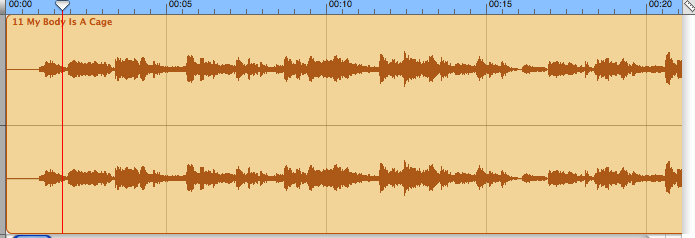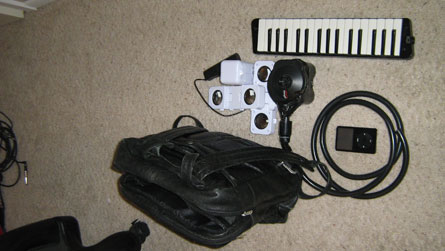Project One: Extended Dissonance
Part I: Theoretical Background
You know that swell moment at 2:10 in Arcade Fire's song “My Body is a Cage” when the organ really kicks in and you get that whoosh feeling? Somehow, at that moment, sound, for me, becomes a feeling. It has the same affect at the same spot for some friends of mine, too. We've commented to one another on this phenomenon.
My sort of vague colloquial explanation is that it is about expectations. The song is structured in such a way that it sets the audience's expectations at a certain point, then exceeds them in successive intervals, creating a sort of emotional payoff. While I started thinking of this issue in terms of audience emotions and expectations, I gradually became more interested in structural, technical, neurological and experimental explorations of the issue that for me was encapsulated in a swell two minutes into a pop song. This exploration led to the creation of an instrument, a pleasant loop, and a sound experiment.
Part II: The Structure of Emotions?
If you look at the structure of the song "My Body is a Cage," there are little swells at, more or less, even intervals leading up to the big pay off. Two of them can be seen in figures 1 and 2, and the big payoff can be seen in figure 3. The song begins a capella and then gradually adds parts, each time creating a little swell.

Figure 1. The intro to the song.
After just over a minute, we have our first orchestrated swell, a sort of medium swell. But we might also refer to this as a sort of our first dose of what is to come. This is the hook, not in the traditional sense of a repeated pop chorus, but rather in the sense that it sets our expectations so that we expect at least this size of swell next time.

Figure 2. The medium swell.
What we get next time is a big, wall-of-sound-style swell. This coincides with the big emotional rush. So by looking at Figures 1, 2 ,and 3, we can visualize how an increase in activity on the track editor interface corresponds to an increased emotional response. (For me, anyway.)

Figure 3. The big swell.
Part III: Sounds and The Brain
But although this structural analysis might say something about the structure of this song or the structuring of audience expectations, it doesn't really explain how music gets translated into a feeling. That must be explained in terms of neurotransmitters.
As I began thinking about how music gets translated into a feeling, I started thinking about neurology. Neuroscience doesn't provide the only vocabulary we could use to talk about this phenomenon, but because of the various new ingenious ways we're learning to study the brain, the language of neuroscience is particularly useful right now.
Not being a neuroscientist myself, I must rely on translators. The popularity of neuroscience (and the influence of my friend, Chris) led me to a Radio Lab segment about Igor Stravinsky's "The Rite of Spring." In brainy vocabulary, the folks at Radio Lab explain how, in the span of a year, "The Rite of Spring" first caused riots and then was lauded by critics as a hugely important work of art. Still later, it became the stuff of Disney movies.
This is what led me to explore the plasticity of our brain and how it adapts to dissonance. It was a lucky coincidence that my gaze happened to fix upon a pump for a long-since-permanently-deflated air mattress, a melodica, and a backpack all in matter of seconds. A length of tube and some duct-tape later (both of which were lying around not far away) and I had the perfect machine for creating dissonance. (See Figure 4.)
Part IV: The Automelodica

Figure 4. The automelodica.
The Automelodica consists of:
- a Colman air mattress pump (takes 4 D batteries)
- a Honer melodica
- a backpack
- a length of tube from Lowe's.
- duct tape
In addition to the Automelodica, for the presentation I used:
- 3 sets of cheap speakers from Office Max.
- a 3-jack headphone booster (takes 2 AA batteries)

Figure 5. The presentation materials.
The thing the automelodica can do that a regular melodica cannot do is sustain until the batteries run out.
Part V: Fabricating an Instrument, Fabricating a Narrative
Now, I'm somewhat refiguring this story to fit a narrative arc. In actuality, what happened was much more recursive. I think I first listened to the radio show months before I ever put together the melodica or started thinking about consonance and dissonance. Then I created the automelodica on a random whim just after the second week of soundscapes. Then I wrote a decidedly consonant song for the presentation of the new instrument. Then I decided I hated the song. Then I started thinking about why I hated it. I hated it because I had been focused on learning to play this new instrument and making tweaks at the expense of making an interesting composition. In the composition, I hadn't thought much about what this new instrument could do that a regular melodica could not. The automelodica allows for the dampening of the air intake valve, which would allow the user to adjust the volume in a performance, thus creating swells like in the above song. This would be one way to use the features of the new instrument add interest to the composition. But this isn't really that different from what can be accomplished with the human respiratory system controlling how much air the instrument gets. While I tried to display this feature in the presentation, I decided it wouldn't be my main focus.

Figure 6. Part of an automelodica track showing the intake valve being starved of air and thus dampening the sound. In class, I used a backpack to do this. At home, I also tried a pillow and my foot.

Figure 7. The presentation.
The more I thought about what this instrument could do, the more I came to a conclusion: the difference was merely indefinite mechanical sustain. I figured I could sustain a really nice chord for a long time. But I had noticed before I hooked it up to the super-lungs that one of the most interesting things about the melodica's sound was its reedy dissonance. I thought of it as one of the most pleasant kinds of dissonance I've heard before. So I thought about sustaining a really dissonant chord over a long period of time.
Then I remembered Stravinsky and the Radio Lab show, and I thought I'd listen to it again until I understood, and could explain in my presentation, what the dissonance was doing on a neurological level. But there was so much good information, I thought I should just play this clip for the class. But then I thought I wouldn't have time to both play a dissonant note long enough to make the point and play the audio clip that explained what was going on. So I just cut up the show and pieced together as much of it as I could fit into five minutes. And then I decided just to play over top of it as a performance of what the show itself was explaining. The result was a performance with metacommentary, a style which I particularly like. Here’s what the finished product sounded like (not the live in-class version).